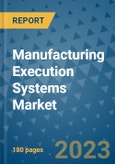Manufacturing execution systems (MES) play a crucial role as the backbone of successful manufacturing processes. These software solutions are essential in connecting multiple plants, providing real-time production information, and integrating enterprise business applications. With their easy integration capabilities and ability to optimize production cycles, MES are vital for comprehensive visibility and efficient production across organizations. As businesses worldwide embrace the Fourth Industrial Revolution, the demand for competent manufacturing execution systems is consistently rising. Furthermore, the global push for agile, sophisticated, cost-efficient, and high-speed production facilities is expected to further drive the demand for MES. Leading industry players in the manufacturing execution systems market are poised to capitalize on these promising trends through rigorous research and development, profitable collaborations, and open innovation endeavors.
Transition to Industry 4.0 Creates Favorable Business Opportunities
As the world adapts to the new normal, embracing emerging technologies has become a key priority for next-generation organizations. Businesses across the globe are rapidly adopting novel technologies to enhance operational efficiency and achieve higher returns on investment. This move is supported by the transition to Industry 4.0, which has witnessed substantial adoption of Internet of Things (IoT), artificial intelligence (AI), automation, machine learning, and cloud technologies in the manufacturing sector. These advancements are projected to bring tangible business benefits, creating favorable prospects for the manufacturing execution systems market. MES enable decision-makers to significantly lower operational costs, enhance enterprise-wide productivity, and reduce human intervention. Consequently, manufacturing execution systems position organizations to better manage uncertainty and respond resiliently, driving robust growth in the market.Pharmaceuticals and Life Sciences Industry to Experience Increased Demand for MES
The pharmaceuticals and life sciences industry is expected to drive higher demand for manufacturing execution systems during the forecast period. Agile production needs, concerns regarding counterfeit drugs, widespread usage of track and trace solutions, strict regulatory compliance, and changing customer behavior are key market drivers in this industry. As a result, the pharmaceuticals and life sciences sector is poised for remarkable growth in the global manufacturing execution systems market. This favorable business landscape is projected to stimulate partnerships, research and development initiatives, and joint ventures among major players in the market.Asia Pacific Emerges as Key Regional Player with Affordable Resources
Asia Pacific is set to become a highly promising region in the global manufacturing execution systems market. The region's strong commitment to advancing Industry 4.0, coupled with the availability of relatively cheaper resources, is expected to drive the demand for MES. Emerging and leading economies in Asia Pacific are actively replacing legacy MES with advanced systems, creating lucrative outcomes and unlocking fruitful opportunities in the manufacturing execution systems market. These positive trends are complemented by government schemes focused on digital transformation, automation, and industrial development.Prominent Market Players
Some of the major players in the global manufacturing execution systems market include Rockwell Automation, Honeywell International Inc., Siemens AG, Werum IT Solutions, Dassault Systèmes SE, ABB Ltd., and AVEVA Plc. These companies are at the forefront of the market, driving innovation and shaping the future of manufacturing execution systems.Table of Contents
1. Executive Summary
2. Market Overview
3. Global Manufacturing Execution Systems Market Outlook, 2019 - 2030
4. North America Manufacturing Execution Systems Market Outlook, 2019 - 2030
5. Europe Manufacturing Execution Systems Market Outlook, 2019 - 2030
6. Asia Pacific Manufacturing Execution Systems Market Outlook, 2019 - 2030
7. Latin America Manufacturing Execution Systems Market Outlook, 2019 - 2030
8. Middle East & Africa Manufacturing Execution Systems Market Outlook, 2019 - 2030
9. Competitive Landscape
10. Appendix
Companies Mentioned
- Siemens AG
- Rockwell Automation
- Honeywell International
- ABB Ltd.
- Aveva Group Plc
- Oracle Corporation
- General Electric
- SAP SE
- Emerson Electric
- Dassault Systemes S.A.
- Hitachi
- Yokogawa
Methodology

LOADING...








